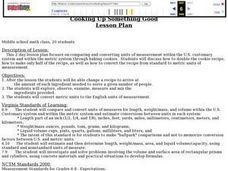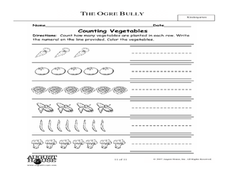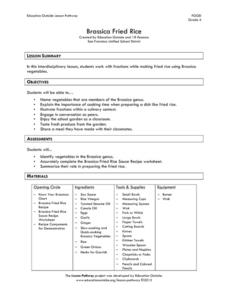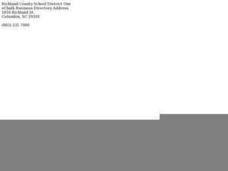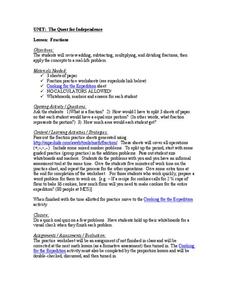Curated OER
Cooking Up Something Good
Students compare and convert units of measurement within the United States customary system and within the metric system by baking cookies. Students discuss how to double the cookie recipe, how to make only half of the recipe, and how to...
August House
The Ogre Bully
English language arts, math, science, dramatic arts, and cooking; this lesson has it all! In this multidisciplinary resource, your scholars will take part in a read aloud of The Ogre Bully by A.B. Hoffmire and have a grand...
Curated OER
Handcarts - A Unique Form of Transportation
An interesting historical fact about how handcarts benefitted to the Mormon pioneers is the context behind this math lesson. Using given facts and figures regarding the handcart, pupil pairs create math word problems, share them with the...
Curated OER
Home Living/ Daily Living: Cooking Mastery
Learning to cook, follow directions, and presenting information are skills every body needs to know. Learners complete a recipe-in-a-jar activity to hone these life skills. They follow the directions, choose and use correct measurement...
Curated OER
Cooking with Math
Fourth graders practice multiplication and division with cooking recipes. In this math lesson, 4th graders look at a recipe and change it so that it works for twice as many people or half as many people.
Curated OER
Cooking Cranberry Pudding
Students explore colonial cooking. In this cross curriculum George Washington and colonial America history lesson, students follow a recipe for cranberry pudding, a possible favorite of George and Martha Washington. Students...
Curated OER
Cooking With Cuisinaires
Second graders explore fraction with Cuisenaire Rods. In this fraction instructional activity, 2nd graders recieve "recipe" cards for adding fractions. After practicing, students create their own cards then exchange with...
Curated OER
Home Living / Daily Living : Measure Ingredients
Cooking often requires one to measure out ingredients. Build an understanding of relative measurements as well as a reference for future cooking projects with your special needs class. In a small group, you'll discuss various measurement...
Curated OER
The Ogre Bully Lesson
Students investigate bullies, agriculture and cooking by completing worksheets about a book they read. In this story analysis lesson plan, students read the story The Ogre Bully, and discuss bullying as well as farming with their...
Education Outside
Brassica Fried Rice
Here's a delicious way to engage fourth graders into working with fractions. Kids chop brassica or cruciferous vegetables, measure the required ingredients, and add them to cooked rice to produce a delicious treat.
Curated OER
Fractions: Mud Pie Math
Second graders identify and name fractional parts through the use of mud pie manipulatives. In this fractional manipulatives lesson plan, 2nd graders identify and label halves, thirds, fourths, sixths, eighths, and tenths and order them...
Curated OER
One-digit Division
Young mathematicians read the book, The Doorbell Rang. They examine the necessity of division in everyday life, such as cooking and sharing. They use paper cookies to construct equivalent sets.
Curated OER
Rooster's Night Out
Mitch Weiss and Martha Hamilton's Rooster's Night Out, a retelling of a classic Cuba folktale, launches a cross-curricular study of Cuban cultural traditions. Class members draw the characters from the book, participate in math and...
Curated OER
Fraction Frenzy
Second graders identify fractions as part of a set. They explain concrete and symbolic representations of whole numbers, fractions, decimals, and percents in real-world situations. They complete a web-based cookie baking lesson.
Curated OER
Corn Field Math
Students complete problems dealing with whole numbers, fractions and percents. After exploring the history of corn and related farming vocabulary, students work in pairs to solve multi-step problems. They incorporate the use of number...
Curated OER
Fractions
Students solve problems with fractions without using a calculator. In this algebra lesson, students practice reducing, converting, adding, subtracting and multiplying fractions. They apply the use of fractions to the real world.
WakeGOV
Plastic Sight Words
Plastic math? Have young learners count and name the number of plastic items in their centers. Kindergartners match sight word cards to the number of plastics in a given group, while learning that plastics come in all different shapes,...
Curated OER
Proportion
Students investigate proportion and ratio. In this geometry lesson, students set up the ratios of proportions correctly and solve for the unknown. They relate it to word problems.
Curated OER
Recipe For Disaster
Students play an interactive game online to learn ratios. In this statistics lesson, students solve problems in an online game about ratio and relating statistics to the real world. This lesson provides hands on as well as teaching time.
Curated OER
Class Ketchup
Students describe statistics by conducting a class cooking activity. In this ketchup lesson, students conduct a class survey based on ketchup consumption habits by students. Students utilize tomatoes, water and a bottle to create their...
Curated OER
Tzedakah: How Can We Help?
Young scholars define what constitutes a nutritious meal, the price of a healthy meal, and understand that some people can't afford healthy meals. In this healthy meals lesson plan, students estimate and research the cost of a nutritious...
K5 Learning
Changes
You can't unring a bell, but can you unmelt an ice cube? Readers consider reversible and irreversible changes with a short informational reading passage and accompanying comprehension questions.
Perkins School for the Blind
Grocery Shopping
Grab those reusable bags, it's time to go shopping! Intended to foster independent living skills in learners with visual impairments, the instructional activity covers several topics related to grocery shopping. They start by planning a...
Curated OER
Double or More
Students practice cooking by following recipe instructions. In this measuring lesson, students read food recipes and collect the materials needed to make one batch, then double the recipe to create twice as much food....
